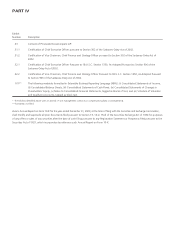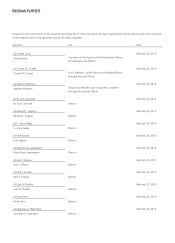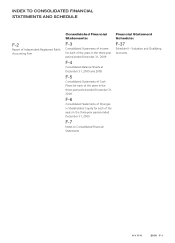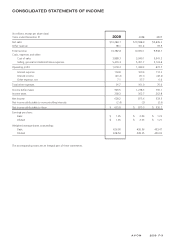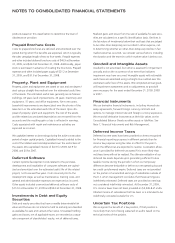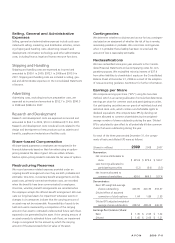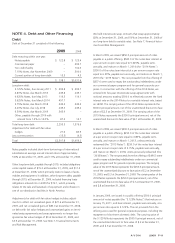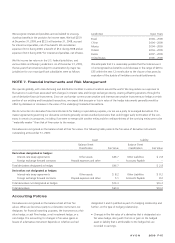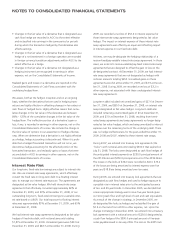Avon 2009 Annual Report Download - page 72
Download and view the complete annual report
Please find page 72 of the 2009 Avon annual report below. You can navigate through the pages in the report by either clicking on the pages listed below, or by using the keyword search tool below to find specific information within the annual report.NOTES TO CONSOLIDATED FINANCIAL STATEMENTS
products based on this classification to determine the level of
obsolescence provision.
Prepaid Brochure Costs
Costs to prepare brochures are deferred and amortized over the
period during which the benefits are expected, which is typically
the sales campaign length of twotofour weeks. Prepaid expenses
and other included deferred brochure costs of $46.9 at December
31, 2009, and $44.0 at December 31, 2008. Additionally, paper
stock is purchased in advance of creating the brochures. Prepaid
expenses and other included paper supply of $21.2 at December
31, 2009, and $31.6 at December 31, 2008.
Property, Plant and Equipment
Property, plant and equipment are stated at cost and are depreci-
ated using astraight-line method over the estimated useful lives
of the assets. The estimated useful lives generally are as follows:
buildings, 45 years; land improvements, 20 years; machinery and
equipment, 15 years; and office equipment, five to ten years.
Leasehold improvements are depreciated over the shorter of the
lease term or the estimated useful life of the asset. Upon dis-
posal of property, plant and equipment, the cost of the assets
and the related accumulated depreciation are removed from the
accounts and the resulting gain or loss is reflected in earnings.
Costs associated with repair and maintenance activities are
expensed as incurred.
We capitalize interest on borrowings during theactive construction
period of major capital projects. Capitalized interest is added to the
cost of the related asset and depreciated over the useful lives of
the assets. We capitalized interest of $4.9 for 2009, $4.9 for
2008, and $0 for2007.
Deferred Software
Certain systems development costs related to the purchase,
development and installation of computer software are capital-
ized and amortized over the estimated useful life of the related
project, not to exceed five years. Costs incurred prior to the
development stage, as well as maintenance, training costs, and
general and administrative expenses are expensed as incurred.
Other assets included unamortized deferred software costs of
$112.0 at December 31, 2009 and $98.3 at December 31, 2008.
Investments in Debt and Equity
Securities
Debt and equity securities that have areadily determinable fair
value and that we do not intend to hold to maturity are classified
as available-for-sale and carried at fair value. Unrealized holding
gains and losses, net of applicable taxes, are recorded as asepa-
rate component of shareholders’ equity, net of deferred taxes.
Realized gains and losses from the sale of available-for-sale secu-
rities are calculated on aspecific identification basis. Declines in
the fair values of investments below their cost basis that are judged
to be other-than-temporary are recorded in other expense, net.
In determining whether an other-than-temporary decline in fair
market value has occurred, we consider various factors, including
the duration and the extent to which market value is below cost.
Goodwill and Intangible Assets
Goodwill is not amortized, but rather is assessed for impairment
annually and on the occurrence of an event that indicates
impairment may have occurred. Intangible assets with estimable
useful lives are amortized using astraight-line method over the
estimated useful lives of the assets. We completed annual good-
will impairment assessments and no adjustments to goodwill
were necessary for the years ended December 31, 2009, 2008
or 2007.
Financial Instruments
We use derivative financial instruments, including interest-rate
swap agreements, forward foreign currency contracts and
options, to manage interest rate and foreign currency exposures.
We record all derivative instruments at their fair values on the
Consolidated Balance Sheets as either assets or liabilities. See
Note 7, Financial Instruments and Risk Management.
Deferred Income Taxes
Deferred income taxes have been provided on items recognized
for financial reporting purposes in different periods than for
income tax purposes using tax rates in effect for the year in
which the differences are expected to reverse. Avaluation allow-
ance is provided for deferred tax assets if it is more likely than
not these items will not be realized. The ultimate realization of our
deferred tax assets depends upon generating sufficient future
taxable income during the periods in which our temporary
differences become deductible or before our net operating loss and
tax credit carryforwards expire. Deferred taxes are not provided
on the portion of unremitted earnings of subsidiaries outside of
the U.S. when management concludes that these earnings are
indefinitely reinvested. Deferred taxes are provided on earnings
not considered indefinitely reinvested. At December 31, 2009,
U.S. income taxes have not been provided on $2,246.8 of undis-
tributed income of subsidiaries that has been or is intended to be
indefinitely reinvested outside the U.S.
Uncertain Tax Positions
We recognize the benefit of atax position, if that position is
more likely than not of being sustained on audit, based on the
technical merits of the position.


